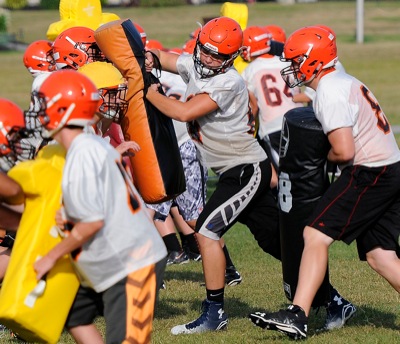Thursday, September 8th, 2016
Grey: Tests on bones give few clues
Sheriff says case difficult to solve
By William Kincaid
CELINA - Forensic experts say human bones found south of the city on Jan. 3 are those of a male.
But other than the gender of the potential homicide victim, investigators have scant details with which to work and continue to ask for tips.
Mercer County Sheriff Jeff Grey, who held a news conference this morning, provided updates on the case, revealing that full DNA profiles have been extracted from samples of the bones discovered on state-owned land, east of U.S. 127, in a wooded area along Grand Lake.
"It's going to be a very difficult case and probably an impossible case if we can't identify who the victim is," Grey said. "If we can identify the victim, at least we have a place to start."
The University of North Texas determined the bone samples came from a male, confirming an earlier finding by The Ohio Bureau of Criminal Investigation's London lab, which extracted a partial DNA profile from one bone.
The bones are believed to be those of a man of unknown race, ranging in age from 20 to 35 years old and between 5 feet 7 inches and 6 feet 1 inch tall, who went missing in 2015, based on an autopsy completed by forensic anthropologist Dr. Elizabeth Murray of Mount St. Joseph University in Cincinnati. The bones likely were exposed to the elements for three to four months, Grey said.
"We have evidence to believe that this person was the victim of a homicide," Grey said. "For the integrity of the case, we will not release any of that information that leads us to believe that."
UNT personnel extracted two full DNA profiles - nuclear and mitochondrial, Grey said. Nuclear DNA comes from a person's mother and father, and much like a fingerprint, is unique and identifies an individual. Mitochondrial DNA comes from a person's mother.
"Obviously the importance of the nuclear DNA is so we can identify a person," Grey said. "The importance of mitochondrial DNA is we can identify the family unit or family lineage."
The profiles are being loaded into the FBI's Combined DNA Index System's database and The National Institute of Justice's National Missing and Unidentified Persons System, a national repository and resource center for cases involving missing people and unidentified bodies.
If a match is found, the sheriff's office will be notified, Grey said. In the meantime, the office is searching for a lab to conduct a phenotypic DNA, which could provide information about the victim's race and ancestry. Neither UNT nor BCI analyzes for that information, Grey said.
His office has sent computer messages to all law enforcement agencies in Ohio, Pennsylvania, West Virginia, Kentucky, Michigan, Tennessee, Georgia and Florida.
"That message informs agencies that we have located bones and is asking for any missing person they have or bones they may have found," Grey said.
Six missing people from within a 250-mile radius of where the bones were found meet the initial physical description of the potential homicide victim.
"Those people have all been ruled out as they have since been located," Grey said.
The office has spoken to agencies that have found skeletal remains, according to Grey.
"We will not disclose those agencies as we have not found a connection," Grey said. "Now that we have full DNA profiles we will be able to determine if any of their cases have a connection to ours."
The office received 28 tips through its website and phone. Twelve of those are still openly being investigated, Grey noted.
"If we can't identify who this person is, it's going to be nearly impossible to solve, so we need the public's help," Grey said.
Information can be relayed anonymously to the office's website at www.mercercountysheriff.org or tip line at 567-890-8477. Tipsters can also call detectives at 419-586-1450.
"We keep saying they're bones, but that's a person, and that person deserves us to find out who they are and their family needs answers and we need to be able to explain how they died and find the person that did this."
A woman walking her dog Jan. 3 near state park land, east of U.S. 127, in a wooded area along Grand Lake reportedly found several bones and notified the sheriff's office. The skeletal remains were lying in plain view southeast of the mouth of Coldwater Creek, Grey had said.
He would not disclose the number or types of bones recovered but noted investigators do not have a complete skeleton.
"I can tell you that we didn't recover all of them," he said. "We know that animals moved them around."
Initially, the bones were thought to belong to deer because people sometimes dump such carcasses in the area.
However, some bones raised suspicions, so officials took them to the Montgomery County Coroner's Office where doctors determined they very likely were human.
"We tend to think that whoever put the body there isn't from this area, just because of the location on (U.S) 127 and because we don't have anybody missing from the area," Grey said.
Grey said he doesn't know how many suspects may be involved or if the site where they dumped the bones - a secluded area without homes - was chosen in advance.
"If you're driving along and you're looking, that would be a location that would stick out because there's a little place to pull off, there's the woods, there's the tree line," Grey said.

